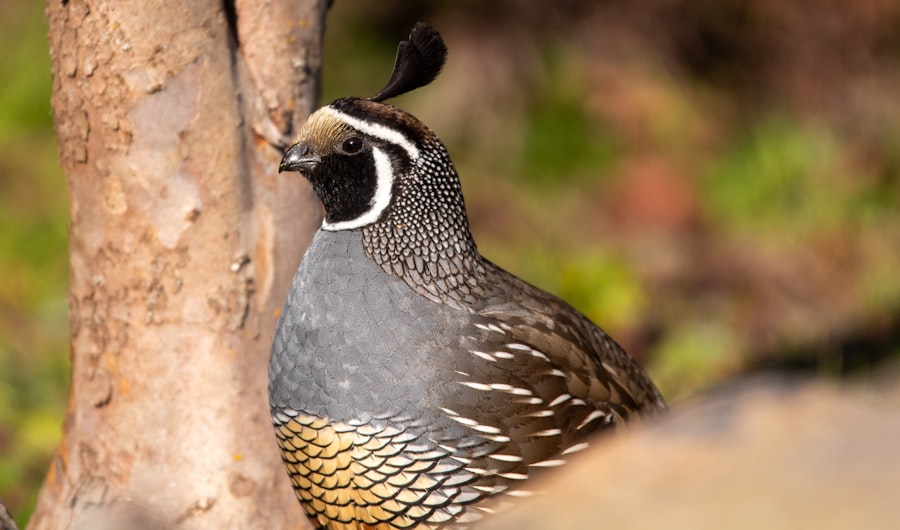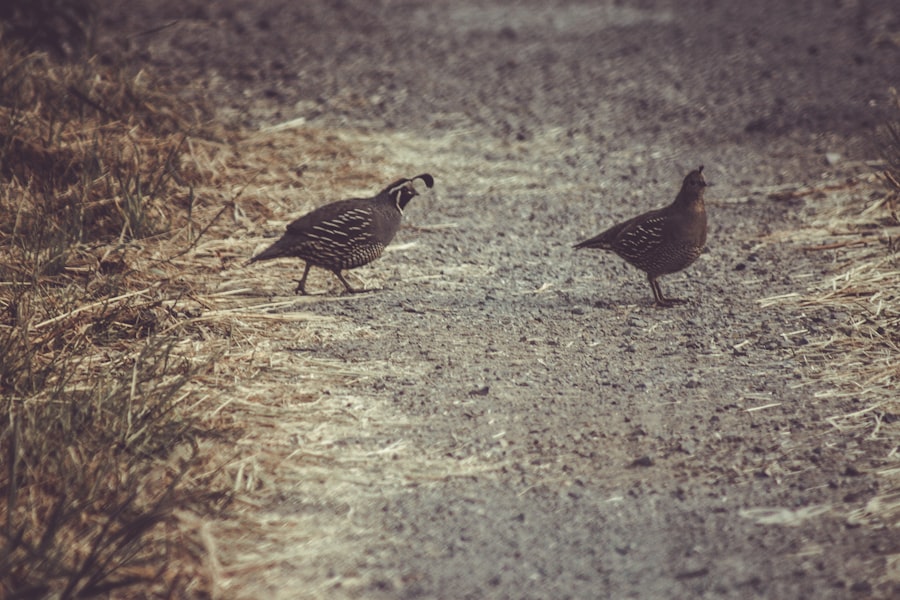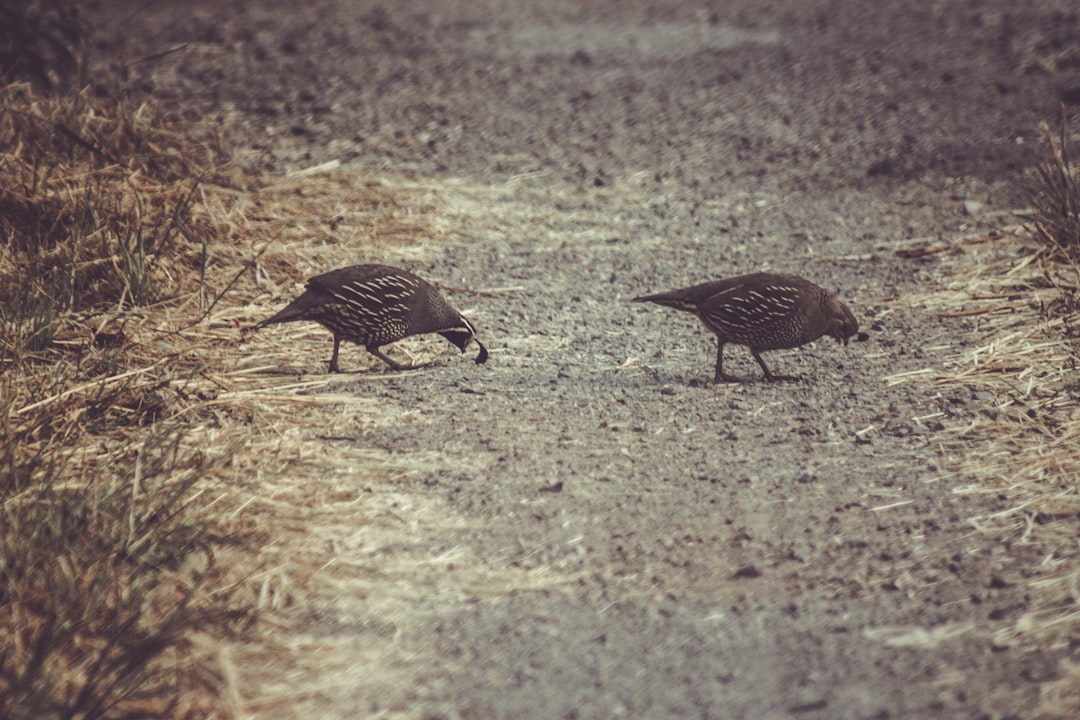Quail play a significant role in maintaining ecological balance within garden ecosystems. These small, ground-dwelling birds are not only charming to observe but also serve as natural pest controllers. By foraging for insects, seeds, and other small invertebrates, quail help to regulate pest populations that can otherwise damage plants.
Their presence can lead to a healthier garden environment, as they contribute to the natural cycle of life by promoting biodiversity. Furthermore, quail are an essential food source for various predators, including hawks and foxes, thus supporting the broader food web. In addition to their ecological contributions, quail can enhance the aesthetic appeal of a garden.
Their distinctive calls and behaviors add a lively element to outdoor spaces, making them more engaging for gardeners and visitors alike. Observing quail can foster a deeper appreciation for wildlife and encourage a connection with nature. This interaction not only enriches the gardening experience but also promotes conservation awareness, as individuals become more invested in creating habitats that support these beautiful birds.
Key Takeaways
- Quail play a vital role in the garden ecosystem by controlling pests and aerating the soil.
- Choose native plants like sunflowers, clover, and wild grasses to attract quail to your garden.
- Create an ideal habitat for quail by providing dense shrubs for cover and open areas for foraging.
- Provide food and water sources such as bird feeders and shallow dishes of water for quail.
- Incorporate shelter and nesting sites like brush piles and rock walls to encourage quail to stay in your garden.
Choosing the Right Plants to Attract Quail
Selecting the appropriate plants is crucial for attracting quail to your garden. Quail are primarily seed eaters, so incorporating a variety of seed-producing plants is essential. Grasses such as foxtail millet, switchgrass, and native wildflowers provide both food and cover for these birds.
Additionally, shrubs like elderberry and serviceberry offer berries that quail enjoy, while also providing shelter from predators. The diversity of plant life not only attracts quail but also supports other wildlife, creating a vibrant ecosystem. When planning your garden layout, consider including a mix of annuals and perennials to ensure a continuous food supply throughout the seasons.
For instance, sunflowers are excellent annuals that produce seeds favored by quail, while perennials like coneflowers and black-eyed Susans can provide sustenance year after year.
By creating a layered planting scheme with varying heights and textures, you can create an inviting environment that encourages quail to visit regularly.
Creating the Ideal Habitat for Quail

To create an ideal habitat for quail, it is essential to mimic their natural environment as closely as possible.
Quail thrive in areas with a mix of open spaces and dense cover, which allows them to forage safely while remaining hidden from predators.
Incorporating patches of native grasses interspersed with wildflowers and shrubs can create this desired habitat structure.
Additionally, leaving some areas of your garden unmowed or allowing native plants to grow wild can provide essential cover for nesting and protection. Another important aspect of habitat creation is ensuring that there are ample ground-level spaces for quail to move freely. They prefer habitats with low vegetation that allows them to forage without being exposed.
Creating small clearings or using low-growing plants can facilitate this need. Furthermore, incorporating features such as brush piles or rock piles can provide additional shelter and nesting opportunities, making your garden a more attractive destination for quail.
Providing Food and Water Sources for Quail
Food and water are critical components of any quail-friendly garden. While planting seed-producing plants is vital, supplementing their diet with additional food sources can enhance their presence. Scatter seeds on the ground or use bird feeders designed for ground-feeding birds to attract quail more effectively.
A mix of grains such as millet, cracked corn, and sunflower seeds can be particularly appealing. Additionally, providing a variety of natural food sources through diverse plantings ensures that quail have access to nutrition year-round. Water sources are equally important for quail, especially during hot summer months when natural water may be scarce.
Installing shallow birdbaths or small ponds can provide quail with the hydration they need. It is essential to keep these water sources clean and free from debris to encourage regular visits. Placing rocks or pebbles in the water can create perches for quail while also preventing drowning risks for smaller birds.
By ensuring that both food and water are readily available, you can significantly increase the likelihood of attracting quail to your garden.
Incorporating Shelter and Nesting Sites for Quail
Creating suitable shelter and nesting sites is vital for encouraging quail to settle in your garden. Quail prefer to nest on the ground in dense vegetation where they feel secure from predators. Planting dense shrubs or grasses in clusters can provide ideal nesting sites.
Native grasses such as big bluestem or little bluestem are excellent choices because they offer both cover and nesting material. Additionally, leaving some areas of your garden undisturbed allows quail to establish nests without disturbance. Incorporating artificial structures can also enhance shelter options for quail.
Brush piles made from fallen branches or twigs can serve as excellent hiding spots and nesting areas. Similarly, creating small brushy thickets or using old logs can provide additional cover. These structures not only benefit quail but also support other wildlife species, contributing to a more diverse ecosystem within your garden.
Using Native Plants to Attract Quail

Utilizing native plants is one of the most effective strategies for attracting quail to your garden. Native plants are well-adapted to local conditions and provide essential food and habitat resources for local wildlife, including quail. They often produce seeds that are highly nutritious and favored by these birds.
For example, native grasses such as Indian grass and prairie dropseed not only produce seeds but also offer cover that quail seek. In addition to grasses, incorporating flowering native plants can attract insects that serve as additional food sources for quail chicks. Plants like milkweed and goldenrod not only support pollinators but also contribute to a balanced ecosystem that benefits quail populations.
By prioritizing native flora in your garden design, you create an environment that is both sustainable and supportive of local wildlife.
Avoiding Pesticides and Chemicals Harmful to Quail
The use of pesticides and chemicals in gardening poses significant risks to quail populations and other wildlife. Many pesticides are toxic not only to the targeted pests but also to beneficial insects and birds that play crucial roles in the ecosystem. Quail are particularly vulnerable due to their ground-foraging habits; they may ingest harmful substances while searching for food.
To create a safe environment for quail, it is essential to adopt organic gardening practices that minimize chemical use. Instead of relying on pesticides, consider implementing integrated pest management (IPM) strategies that focus on prevention and natural control methods. Encouraging beneficial insects such as ladybugs or lacewings can help manage pest populations without harming quail or other wildlife.
Additionally, using companion planting techniques can deter pests naturally while promoting plant health. By fostering a chemical-free garden environment, you not only protect quail but also contribute to the overall health of your garden ecosystem.
Maintaining a Quail-Friendly Garden
Maintaining a quail-friendly garden requires ongoing attention and care to ensure that the habitat remains suitable for these birds over time. Regularly assessing plant health and diversity is crucial; replacing any dead or diseased plants with native species will help maintain a thriving environment. Seasonal maintenance tasks such as pruning shrubs or grasses should be done carefully to avoid disturbing nesting sites during breeding season.
Additionally, monitoring food sources is essential for attracting quail consistently. Regularly replenishing bird feeders with appropriate seeds and ensuring water sources remain clean will encourage frequent visits from these birds. Keeping an eye out for signs of quail activity—such as tracks or droppings—can help you gauge the success of your efforts and make necessary adjustments to improve their habitat further.
Observing and Enjoying Quail in the Garden
Observing quail in your garden can be a rewarding experience that deepens your connection with nature. Setting up observation points where you can quietly watch their behavior without disturbing them allows you to appreciate their unique characteristics fully. Quail are known for their social behavior; they often forage in small groups called coveys, which can be delightful to witness as they interact with one another.
To enhance your observation experience, consider using binoculars or setting up a camera trap to capture their activities without intruding on their space. Documenting their presence through photography or journaling can provide insights into their habits and preferences over time. Sharing these observations with friends or family can inspire others to appreciate wildlife in their own gardens.
Educating Others about the Benefits of Attracting Quail
Educating others about the benefits of attracting quail can foster a greater appreciation for wildlife conservation efforts within communities. Hosting workshops or informational sessions about creating quail-friendly gardens can empower individuals with knowledge about sustainable gardening practices that support local ecosystems. Sharing personal experiences and successes in attracting quail can inspire others to take action in their own outdoor spaces.
Utilizing social media platforms or community bulletin boards to share tips on attracting quail can reach a broader audience. Collaborating with local gardening clubs or wildlife organizations can amplify these efforts, creating a network of individuals committed to promoting biodiversity through gardening practices that benefit both people and wildlife alike.
Resources for Further Information on Quail-Friendly Gardening
For those interested in delving deeper into creating quail-friendly gardens, numerous resources are available that provide valuable information on best practices and plant selections. Local extension services often offer workshops or publications focused on native plants and wildlife gardening techniques tailored to specific regions. Books dedicated to wildlife gardening can also serve as excellent references; titles such as “Bringing Nature Home” by Douglas W.
Tallamy emphasize the importance of native plants in supporting local ecosystems while providing practical advice on gardening strategies that attract various wildlife species, including quail. Online platforms such as the National Audubon Society’s website offer articles and guides on creating bird-friendly habitats that encompass not only quail but also other avian species. By leveraging these resources, gardeners can enhance their understanding of how to create environments that support quail populations while contributing positively to local biodiversity efforts.
If you are interested in learning more about gardening and plant care, you may also want to check out this article on common zinnia diseases and how to identify and treat them. It’s important to be aware of potential issues that may arise in your garden to ensure the health and vitality of your plants.
FAQs
What are some plants that attract quail to the garden?
Some plants that attract quail to the garden include native grasses such as bluestem and sideoats grama, as well as shrubs like sumac, wild rose, and desert hackberry.
How can I encourage quail to visit my garden?
To encourage quail to visit your garden, you can provide food sources such as seeds and insects, as well as cover and nesting sites. Planting native grasses and shrubs can also attract quail to your garden.
What are the benefits of having quail in the garden?
Having quail in the garden can help control insect populations, as quail feed on a variety of insects. Additionally, quail can contribute to the overall biodiversity of the garden ecosystem.
Are there any specific gardening practices that can attract quail?
Creating brush piles and leaving areas of dense vegetation can provide cover and nesting sites for quail. Additionally, reducing the use of pesticides and herbicides can create a more hospitable environment for quail.
What are some common predators of quail in the garden?
Common predators of quail in the garden include domestic cats, birds of prey such as hawks and owls, and ground-dwelling predators like foxes and raccoons. Providing cover and nesting sites can help protect quail from predators.

